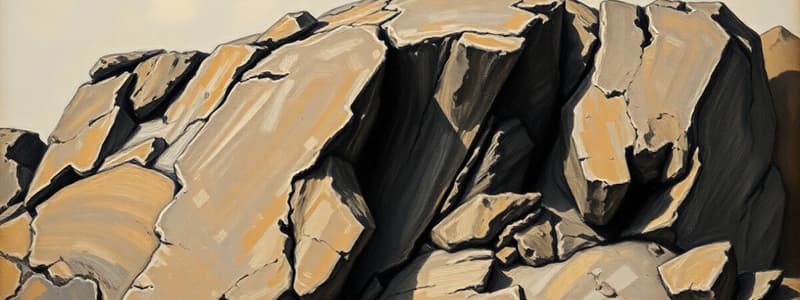Podcast
Questions and Answers
What are the two primary types of folds?
What are the two primary types of folds?
- Plunging and Overturned
- Antiform and Synform
- Anticline and Syncline (correct)
- Folds and Faults
Anticlines are usually formed by downfolding of rock layers.
Anticlines are usually formed by downfolding of rock layers.
False (B)
What is the term for the line drawn along points of maximum curvature in a fold?
What is the term for the line drawn along points of maximum curvature in a fold?
Axis
A fold that lies on its side, making the axial plane horizontal, is called a ______ fold.
A fold that lies on its side, making the axial plane horizontal, is called a ______ fold.
What happens to the ends of folds?
What happens to the ends of folds?
Match the structures with their characteristics:
Match the structures with their characteristics:
What type of stress shortens rocks?
What type of stress shortens rocks?
Most folds are caused by compressional stresses.
Most folds are caused by compressional stresses.
Elastic deformation results in a permanent change in shape or volume.
Elastic deformation results in a permanent change in shape or volume.
What term refers to the changes in the shape or size of a rock body due to stress?
What term refers to the changes in the shape or size of a rock body due to stress?
The limbs of a symmetrical fold diverge at the ______ angle.
The limbs of a symmetrical fold diverge at the ______ angle.
What type of fold is formed when one limb is tilted beyond vertical?
What type of fold is formed when one limb is tilted beyond vertical?
The angle of inclination of the surface of a rock unit or fault is referred to as _____.
The angle of inclination of the surface of a rock unit or fault is referred to as _____.
What describes a portion of the geological structure characterized by vertical movements?
What describes a portion of the geological structure characterized by vertical movements?
Match the types of rock deformation with their definitions:
Match the types of rock deformation with their definitions:
In geological mapping, what does the term 'strike' refer to?
In geological mapping, what does the term 'strike' refer to?
Brittle deformation occurs as a result of high temperature and pressure.
Brittle deformation occurs as a result of high temperature and pressure.
What three factors influence how rocks deform?
What three factors influence how rocks deform?
Shear stress makes the rocks _____ against each other.
Shear stress makes the rocks _____ against each other.
Which type of rock deformation involves permanent change without breaking?
Which type of rock deformation involves permanent change without breaking?
What type of fault occurs when the hanging wall block moves down relative to the footwall?
What type of fault occurs when the hanging wall block moves down relative to the footwall?
All faults can be classified into dip-slip, strike-slip, or oblique-slip categories.
All faults can be classified into dip-slip, strike-slip, or oblique-slip categories.
What are the two surfaces referred to when discussing dip-slip faults?
What are the two surfaces referred to when discussing dip-slip faults?
Normal faults indicate the existence of __________ stresses.
Normal faults indicate the existence of __________ stresses.
Which geological feature is formed by uplifted structures in the context of normal faulting?
Which geological feature is formed by uplifted structures in the context of normal faulting?
What type of faults are classified as reverse faults and thrust faults?
What type of faults are classified as reverse faults and thrust faults?
Match the fault types with their descriptions:
Match the fault types with their descriptions:
Most normal faults are large and have significant displacements.
Most normal faults are large and have significant displacements.
Thrust faults have a dip less than 45 degrees.
Thrust faults have a dip less than 45 degrees.
Name one location where thrust faults can be found.
Name one location where thrust faults can be found.
What is the Great Rift of East Africa primarily made up of?
What is the Great Rift of East Africa primarily made up of?
Normal faults typically occur in regions experiencing __________ stresses.
Normal faults typically occur in regions experiencing __________ stresses.
In a reverse fault, the hanging wall block moves ___ relative to the footwall.
In a reverse fault, the hanging wall block moves ___ relative to the footwall.
Which fault type generally results from compressional stresses?
Which fault type generally results from compressional stresses?
Match the fault types with their definitions:
Match the fault types with their definitions:
Which of the following is an example of a strike-slip fault?
Which of the following is an example of a strike-slip fault?
Reverse faults typically occur in mountain regions.
Reverse faults typically occur in mountain regions.
What is the maximum displacement of strata caused by thrust faults in some mountainous areas?
What is the maximum displacement of strata caused by thrust faults in some mountainous areas?
Strike-slip faults exhibit displacement that is primarily ___ to the strike of the fault surface.
Strike-slip faults exhibit displacement that is primarily ___ to the strike of the fault surface.
Match the following fault types with their characteristics:
Match the following fault types with their characteristics:
Flashcards are hidden until you start studying
Study Notes
Rock Deformation
- Deformation is any change in the original form and/or size of a rock body.
- Stress and strain are involved in rock deformation.
- Stress is force divided by area.
- Strain are changes in the shape or size of a rock body due to stress.
- Stress types include:
- Compressional stress: Shortens rocks
- Tensional stress: Extends rocks
- Shear stress: Causes rocks to slide past each other
How rocks deform
- The behavior of rocks can change depending on stress application, rock type, temperature and pressure:
- Elastic deformation: Temporary changes that allow the material to return to its original shape after stress is removed.
- Ductile deformation: Permanent but gradual change in shape or volume; caused by flowing or bending.
- Brittle deformation: Permanent change in shape or volume; caused by the material breaking or cracking
Mapping Geologic Structures
- Strike: The compass direction of the line where an inclined rock layer or fault intersects with a horizontal plane.
- Dip: The angle of inclination of the surface of a rock layer or fault, measured from a horizontal plane.
Folds
- Folds occur when rock layers bend.
- Limbs: The two sides of a fold.
- Axis: A line drawn along the points of maximum curvature.
- ** Axial plane:** An imaginary surface that divides a fold symmetrically.
- Anticlines: Upward folds with the oldest rocks at the center.
- Synclines: Downward folds with the youngest rocks at the center.
- Plunging Folds: Folds where the axis is not horizontal, and dips down into the Earth.
- Monoclines: A fold with a single, steep dip, creating a step-like structure.
- Domes: Structures where rock layers dip away from a central point.
- Basins: Structures where rock layers dip towards a central point.
Faults
- Faults are fractures in the Earth's crust where rocks have moved past each other.
- They can be classified based on the type of movement:
- Dip-Slip Faults: Movement is primarily vertical.
- Normal Faults: The hanging wall block moves down.
- Reverse Faults: The hanging wall moves up (dip greater than 45 degrees).
- Thrust faults: The hanging wall moves up (dip less than 45 degrees).
- Strike-Slip Faults: Movement is primarily horizontal.
- Oblique-Slip Faults: Movement is both horizontal and vertical.
- Dip-Slip Faults: Movement is primarily vertical.
Fault Terminology
- Hanging Wall: The rock block above the fault.
- Footwall: The rock block below the fault.
Examples
- Fault-Block Mountains: Caused by normal faulting.
- Graben: A block of land that has sunk between two normal faults.
- Horst: A block of land that has been uplifted between two normal faults.
- The San Andreas Fault: A major strike-slip fault in California.
Studying That Suits You
Use AI to generate personalized quizzes and flashcards to suit your learning preferences.



